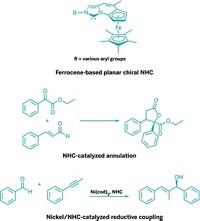Advertisement
Grab your lab coat. Let's get started
Welcome!
Welcome!
Create an account below to get 6 C&EN articles per month, receive newsletters and more - all free.
It seems this is your first time logging in online. Please enter the following information to continue.
As an ACS member you automatically get access to this site. All we need is few more details to create your reading experience.
Not you? Sign in with a different account.
Not you? Sign in with a different account.
ERROR 1
ERROR 1
ERROR 2
ERROR 2
ERROR 2
ERROR 2
ERROR 2
Password and Confirm password must match.
If you have an ACS member number, please enter it here so we can link this account to your membership. (optional)
ERROR 2
ACS values your privacy. By submitting your information, you are gaining access to C&EN and subscribing to our weekly newsletter. We use the information you provide to make your reading experience better, and we will never sell your data to third party members.
Synthesis
Asymmetry From A Guest
Stereochemistry: Enzymelike pocket that hosts chiral species controls catalyst’s enantioselectivity
by Stephen K. Ritter
October 17, 2011
| A version of this story appeared in
Volume 89, Issue 42

An achiral rhodium catalyst equipped with a binding pocket to host chiral guest molecules mimics the way some enzymes modulate catalytic functions. The chemistry generates transition-metal complexes whose catalytic activity and enantioselectivity can be controlled independently, say the researchers who created the system. It offers, they add, another tool for preparing biologically active compounds for pharmaceutical and agricultural applications.

Drawing inspiration from nature and from transition-metal catalysis, Joost N. H. Reek of the University of Amsterdam and coworkers started with an achiral ligand made up of a pair of diphenylphosphine groups bridged by an amidoindolyl-based framework. When this supramolecular ligand attaches to rhodium, it creates a binding pocket next to the metal.
The pocket has the chemical functionality and is just the right size to hold anionic forms of chiral α-hydroxy acids and α-amino acids, Reek notes. In the pocket, the chiral anions behave like cofactors, which are reactive small molecules needed by some enzymes for their activity. When the achiral rhodium complex noncovalently binds a chiral anion, the conformation of the complex shifts: The anion effectively transfers its chirality to the rhodium complex (J. Am. Chem. Soc., DOI: 10.1021/ja208589c).
Reek’s team tested the “cofactor”-controlled system by hydrogenating enamide compounds such as methyl 2-acetamidoacrylate. The researchers obtained the highest enantioselectivity using a thiourea or a carbamate derivative as the cofactor. In control experiments they observed that both a bound cofactor and the bisphosphine ligand are necessary. The binding site must be an integrated part of the system near the metal center; otherwise, the catalyst has no enantioselectivity and forms racemic mixtures of products.
The researchers also carried out “natural selection” competition experiments with mixtures of 12 cofactors that fight over the catalyst binding site. They discovered that the winning cofactor from a mixture is the one that binds strongest to the rhodium complex and also induces the highest enantioselectivity. The competition experiments, Reek says, are an efficient way to screen a large library of compounds and could be used to select the best cofactors for other biomimetic metal-ligand systems.
“This is very beautiful work that harnesses the peculiar behavior of molecules in very small spaces,” comments Julius Rebek Jr., director of the Skaggs Institute for Chemical Biology at Scripps Research Institute. His research includes developing supramolecular structures that mimic enzyme-type regulation of catalyst activity. “The self-selection of cofactors makes this a ‘smart’ system,” Rebek says. “Rapid development of supramolecular catalysts should now be possible by Reek’s group.”
The Amsterdam chemists have patented the strategy and plan to develop it alongside their other high-throughput ligand-screening strategies through a spin-off company, InCatT.







Join the conversation
Contact the reporter
Submit a Letter to the Editor for publication
Engage with us on Twitter